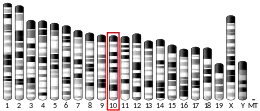Monocarboxylate transporter 9
Monocarboxylate transporter 9 (MCT9, solute carrier family 16, member 9, SLC16A9) is a protein that in humans is encoded by the SLC16A9 gene.[5]
Clinical relevance
Mutations in the SLC16A9 gene have been associated with carnitine levels in blood.[6]
References
- GRCh38: Ensembl release 89: ENSG00000165449 - Ensembl, May 2017
- GRCm38: Ensembl release 89: ENSMUSG00000037762 - Ensembl, May 2017
- "Human PubMed Reference:". National Center for Biotechnology Information, U.S. National Library of Medicine.
- "Mouse PubMed Reference:". National Center for Biotechnology Information, U.S. National Library of Medicine.
- "Entrez Gene: solute carrier family 16".
- Suhre K, Shin SY, Petersen AK, Mohney RP, Meredith D, Wägele B, Altmaier E, Deloukas P, Erdmann J, Grundberg E, Hammond CJ, de Angelis MH, Kastenmüller G, Köttgen A, Kronenberg F, Mangino M, Meisinger C, Meitinger T, Mewes HW, Milburn MV, Prehn C, Raffler J, Ried JS, Römisch-Margl W, Samani NJ, Small KS, Wichmann HE, Zhai G, Illig T, Spector TD, Adamski J, Soranzo N, Gieger C, Assimes TL, Deloukas P, Erdmann J, Holm H, Kathiresan S, König IR, McPherson R, Reilly MP, Roberts R, Samani NJ, Schunkert H, Stewart AF (September 2011). "Human metabolic individuality in biomedical and pharmaceutical research". Nature. 477 (7362): 54–60. Bibcode:2011Natur.477...54S. doi:10.1038/nature10354. PMC 3832838. PMID 21886157.
Further reading
- Kolz M, Johnson T, Sanna S, et al. (2009). "Meta-analysis of 28,141 individuals identifies common variants within five new loci that influence uric acid concentrations". PLOS Genet. 5 (6): e1000504. doi:10.1371/journal.pgen.1000504. PMC 2683940. PMID 19503597.
- Gunjaca G; Boban M; Pehlić M; et al. (2010). "Predictive value of 8 genetic loci for serum uric acid concentration". Croat. Med. J. 51 (1): 23–31. doi:10.3325/cmj.2010.51.23. PMC 2829178. PMID 20162742.
- Grupe A, Li Y, Rowland C, et al. (2006). "A scan of chromosome 10 identifies a novel locus showing strong association with late-onset Alzheimer disease". Am. J. Hum. Genet. 78 (1): 78–88. doi:10.1086/498851. PMC 1380225. PMID 16385451.
- Polasek O; Jeroncić I; Mulić R; et al. (2010). "Common variants in SLC17A3 gene affect intra-personal variation in serum uric acid levels in longitudinal time series". Croat. Med. J. 51 (1): 32–9. doi:10.3325/cmj.2010.51.32. PMC 2829186. PMID 20162743.
- Stark K, Reinhard W, Grassl M, et al. (2009). "Common polymorphisms influencing serum uric acid levels contribute to susceptibility to gout, but not to coronary artery disease". PLOS ONE. 4 (11): e7729. Bibcode:2009PLoSO...4.7729S. doi:10.1371/journal.pone.0007729. PMC 2766838. PMID 19890391.
- van der Harst P, Bakker SJ, de Boer RA, et al. (2010). "Replication of the five novel loci for uric acid concentrations and potential mediating mechanisms". Hum. Mol. Genet. 19 (2): 387–95. doi:10.1093/hmg/ddp489. PMID 19861489.
- Illig T, Gieger C, Zhai G, et al. (2010). "A genome-wide perspective of genetic variation in human metabolism". Nat. Genet. 42 (2): 137–41. doi:10.1038/ng.507. PMC 3773904. PMID 20037589.
- Halestrap AP, Meredith D (2004). "The SLC16 gene family-from monocarboxylate transporters (MCTs) to aromatic amino acid transporters and beyond". Pflügers Arch. 447 (5): 619–28. doi:10.1007/s00424-003-1067-2. PMID 12739169. S2CID 15498611.
This article is issued from Wikipedia. The text is licensed under Creative Commons - Attribution - Sharealike. Additional terms may apply for the media files.



